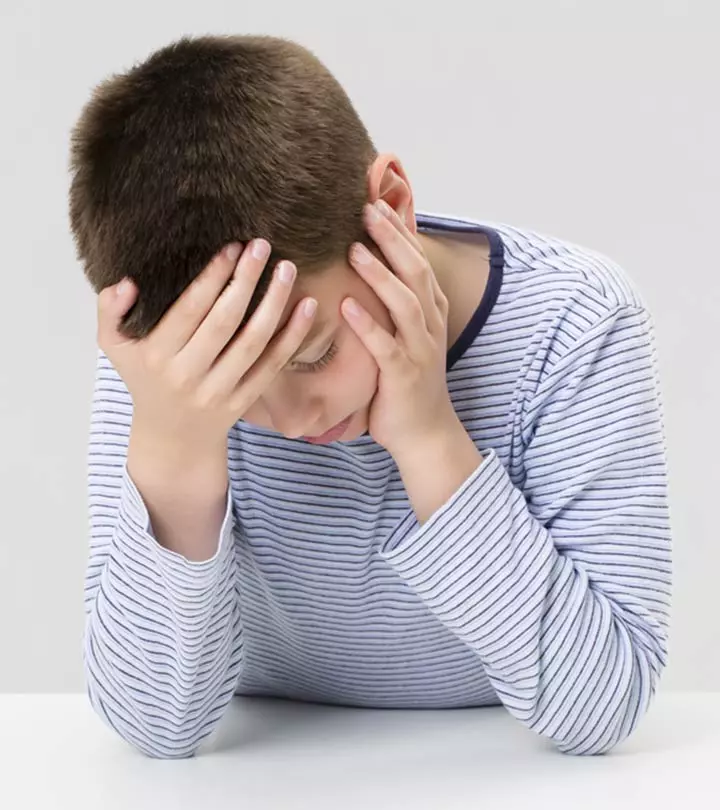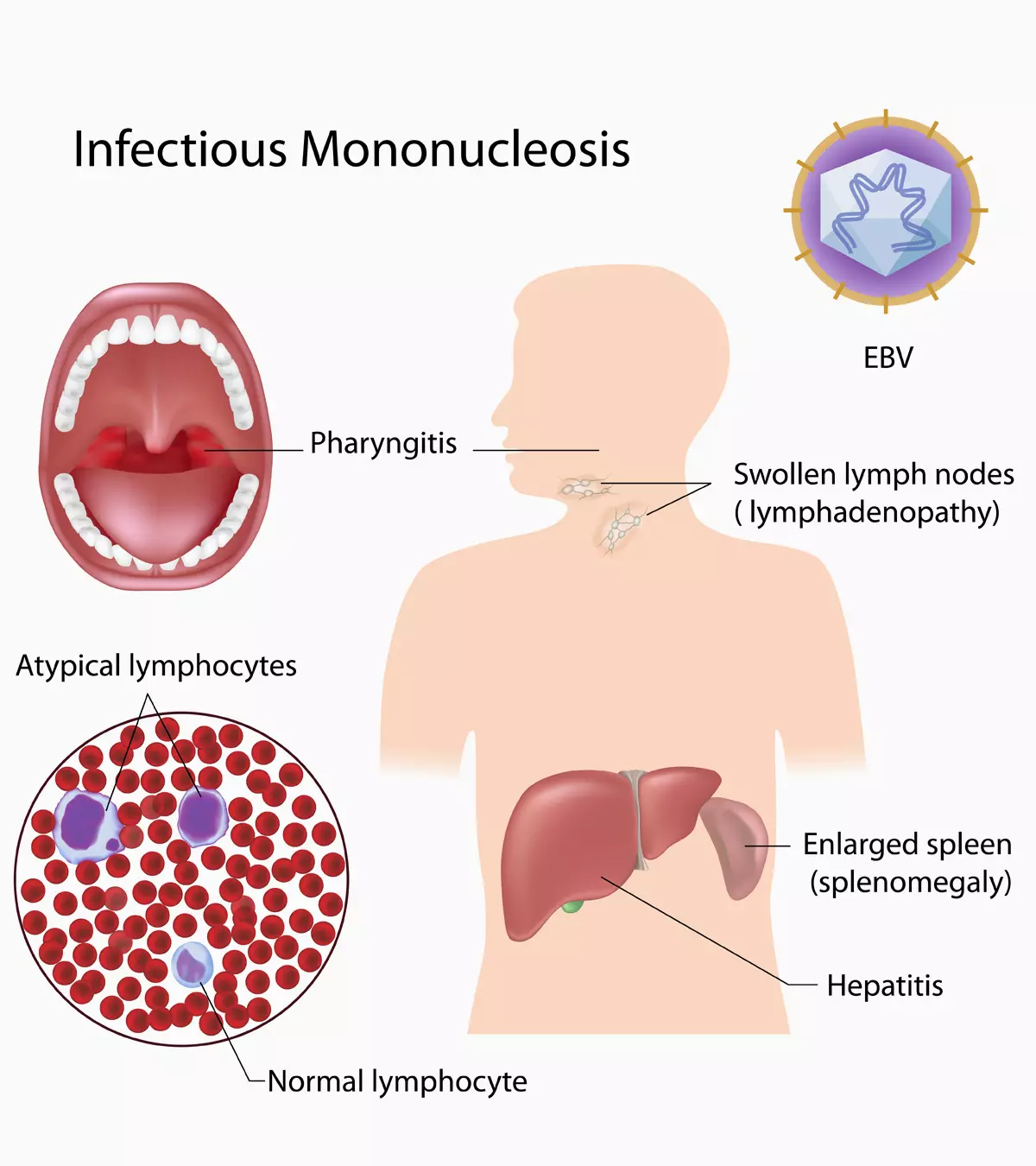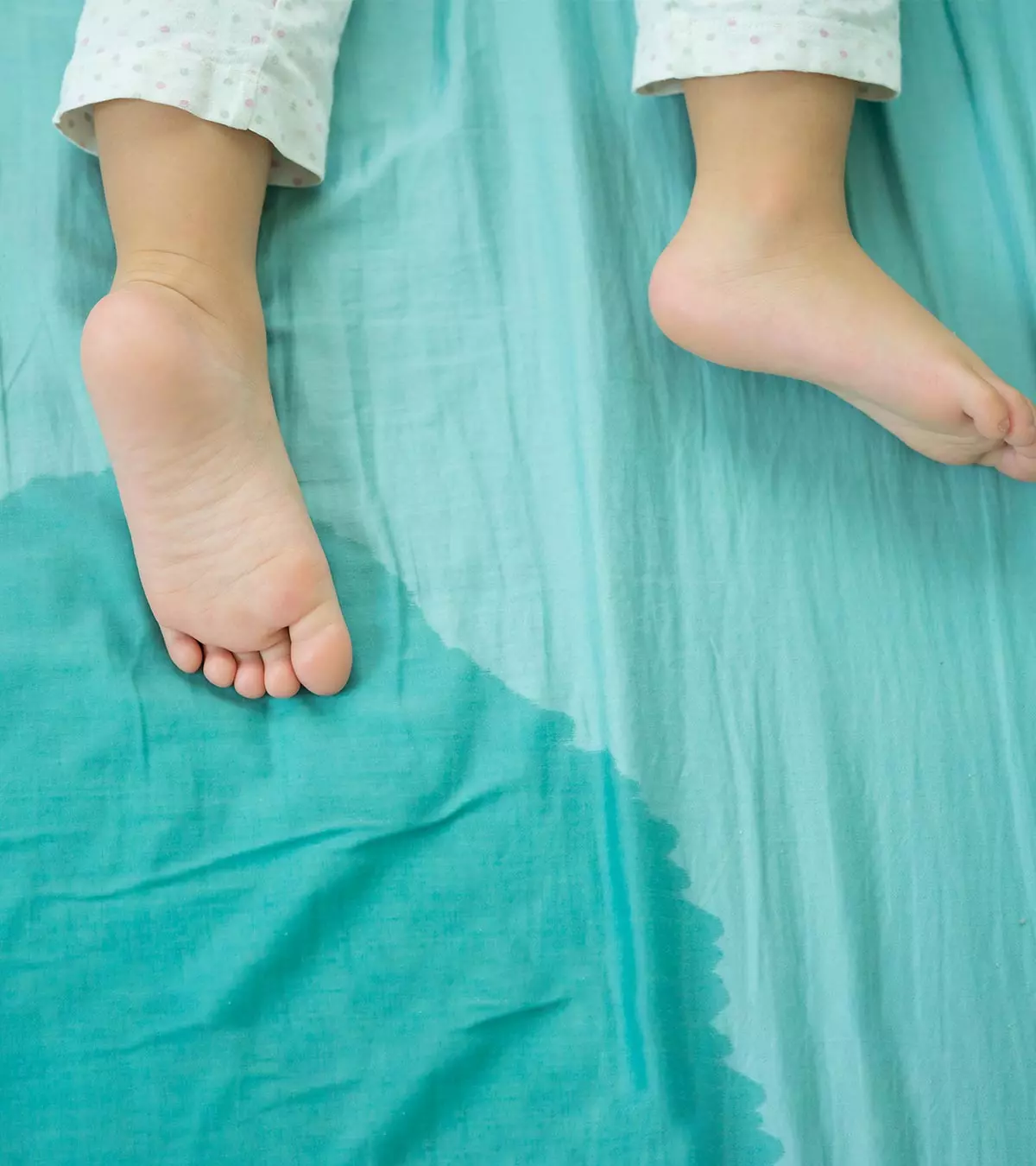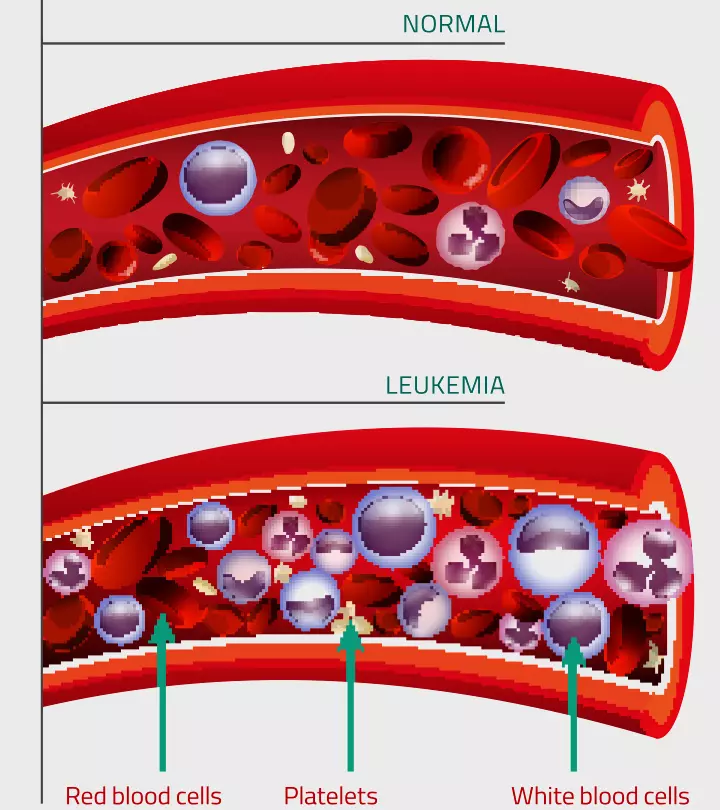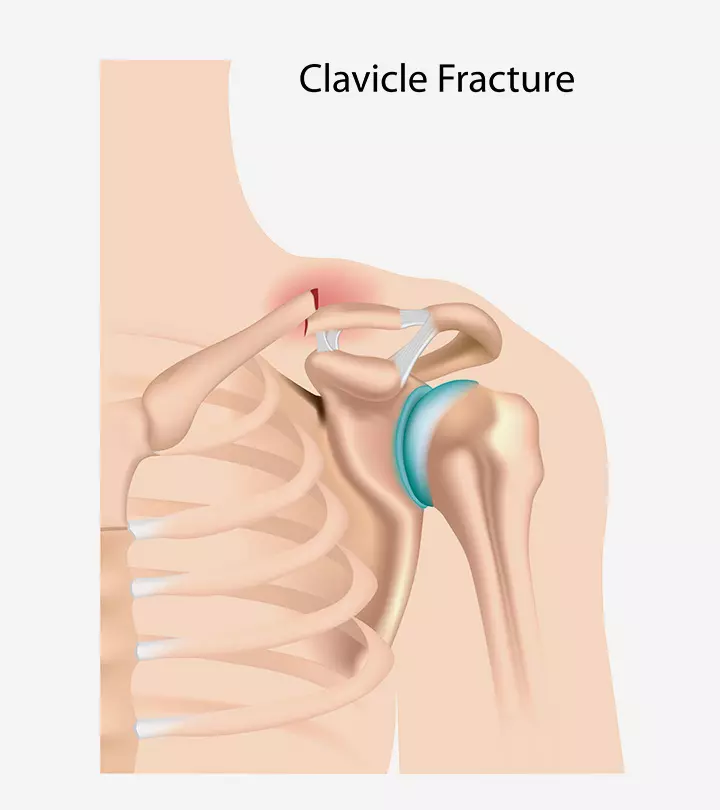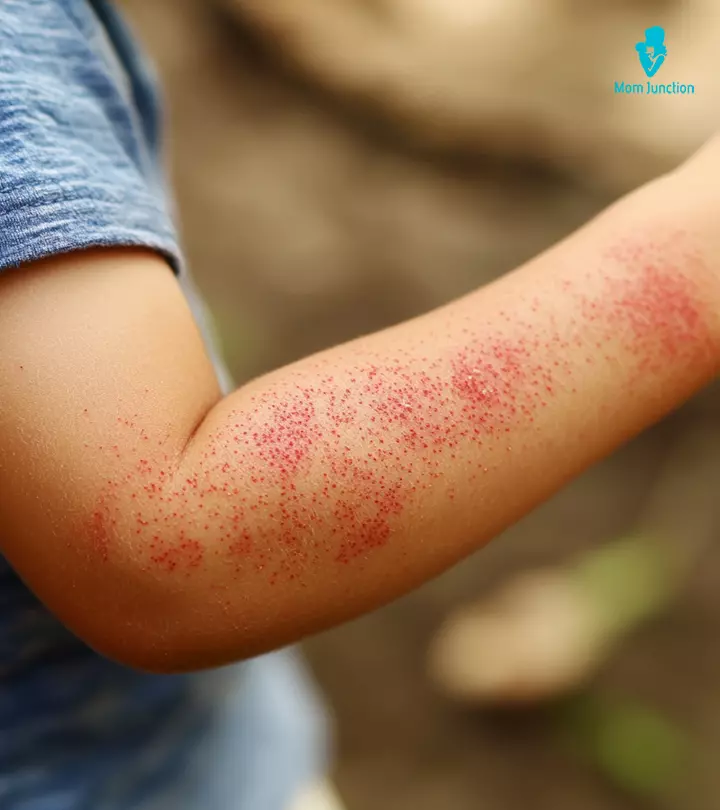
Image: Midjourney/ MomJunction Design Team
Viral rash in children, also known as viral exanthem, occurs when the skin is inflamed due to a viral infection (1). The rash may be in one spot (localized) or on the entire body (widespread), appearing as bumps, reddish-pink blotches, pimples, or blisters (2). In rare cases, the rash may cause itching, stinging, or a burning sensation. Depending on the kind of viral infection that caused it, a viral rash may resolve on its own or require treatment. Usually, the rash takes a few days to around two weeks to resolve once the treatment has begun. Parents should consult a doctor if their children develop fever, cough, and rash. The timely identification of the symptoms is crucial for adequate medical intervention and prevention of complications. Read this post to understand the different types of viral rash in children, treatment options, and tips for effective prevention.

Key Pointers
- Chickenpox, measles, and rubella are some viral illnesses that cause rashes in children.
- A doctor may diagnose a viral rash by physically examining it and assessing its associated signs and symptoms.
- Homecare, including proper rest and drinking plenty of fluids, is the most crucial aspect of managing a viral rash.
Types Of Viral Rash In Children
Viral rash in children can be of different types. The type depends on the virus responsible for the infection (1). Often, children get additional symptoms, such as fever and vomiting, along with the rash.
Here are some of the common viral infections that occur in children and cause a viral rash.
1. Measles (Rubeola)

Measles, also known as rubeola or 10-day measles, is a highly contagious viral infection caused by the measles virus belonging to the genus Morbillivirus (3). The infection spreads from one child to another through direct contact with the infected child’s body fluids, such as nasal and throat discharge, or via airborne droplets when an infected child coughs or sneezes without covering their mouth.
Infographic: Common Viral Infections That Lead To Rashes In Children
Some thing wrong with infographic shortcode. please verify shortcode syntaxThe skin rash caused by the infection usually appears two weeks after the child is exposed to the virus. The rash appears as a deep, red, flat rash and generally spreads from the head or neck to the limbs and lower extremities (cephalo-caudal distribution). The rash begins to clear three to four days after its appearance. Some of the other symptoms and signs that often accompany measles rash include (1) (4).
- Hacking cough
- Fever
- Runny nose
- Redness and irritation of the eyes
- Vomiting
- Diarrhea
Since rubeola is a viral infection, the treatment focuses on symptomatic relief by decreasing the severity of the infection. It is best prevented through vaccination. In 2025, the US reported a total of 607 measles cases. Of these, 196 cases (32%) were in children under 5 years old, and 240 cases (40%) were in children and teens aged 5 to 19 (5).
 Quick fact
Quick fact2. Roseola Infantum

Roseola Infantum is a common and contagious viral infection caused by human herpesvirus 6 (HHV-6), and less frequently by human herpesvirus 7 (HHV-7). It mostly occurs in children under three years of age (6). The illness begins with a high fever that usually lasts for two to three days, followed by a rash.
As the fever subsides, pinkish-red rashes with flat or raised patches or bumps appear on the abdominal region and spread to the face and limbs. A study by the University of Rochester School of Medicine and Dentistry indicates that 30% of children with roseola infantum have an onset of rash following a day of persistent fever (7). The rash isn’t itchy and lessens or disappears after two to three days. Some other symptoms of roseola include (8).
- Loss of appetite
- Cold-like symptoms such as a sore throat, runny nose, and cough
- Swollen glands in the neck
- Swollen eyelids
In the US, roseola-induced fever sums up to about 45% of all fevers in babies. About 12% of all infants taken to the ER for a fever have roseola (9). Roseola in children is self-limiting, and the treatment plan usually focuses on measures for symptomatic relief, such as acetaminophen for fever management. In addition, rest and proper fluid intake help recovery. Children are most contagious when they have a high fever, and once the fever subsides, the child is no longer contagious, even if the rash is present.
3. Chickenpox (Varicella)

Chickenpox is a highly contagious viral infection and one of the most common causes of skin rashes in children. It commonly affects children between five and nine years of age (1) (10).
The disease can cause a rash that starts as a small red bump and gradually changes to blisters or spots, then to open sores, and finally, scabs. The rash appears on the chest, back, and face and spreads to other body parts, including the genitals.
Since the blisters are itchy, children tend to scratch them, which can cause scars after healing. Also, it may raise the risk of skin infections, such as cellulitis. Some other symptoms that a child with chickenpox may manifest are (11) (12):
- Fatigue and irritability (one to two days before the rash appears)
- Fever and malaise
- Reduced appetite
- Joint or muscle pain
- Cold-like symptoms
- Stomach pain
Chickenpox may last for up to a week, during which crops of new chickenpox lesions keep appearing. Vaccination is the best way to prevent its occurrence. Since the varicella vaccination program’s implementation, there has been a significant decline in cases, hospitalizations, and deaths (13).
 Quick tip
Quick tip4. Hand, foot, and mouth disease (HFMD)

Hand-foot-mouth disease is a highly contagious infection caused by coxsackieviruses from the enterovirus family (14).
It is a common childhood disease affecting children under five years of age who go to school and daycare facilities. However, it can occur at any age and spread from one person to another through respiratory droplets, contaminated surfaces, and person-to-person contact.
Its common symptoms include fever, mouth sores, sore throat, and rash on the hand, mouth, and face. The rash looks like flat, red spots, sometimes with blisters filled with fluid that turns into scabs once the rash begins healing. Most children have mild symptoms for up to a week to ten days. A child with hand, foot, and mouth disease (HFM) may also show these signs (15):
- Fever
- Muscle aches
- Flu-like symptoms
- Upset stomach, including vomiting, diarrhea, or belly pain
- Irritability or tiredness
Hand, foot, and mouth disease (HFMD) has a high incidence. In some countries, each year, it affects between 90 to 2,400 individuals out of 100,000 (16). Since the disease has no cure, the treatment focuses on symptomatic relief. Further, there’s no vaccine for HFMD. Thus, maintaining good hygiene is the only preventive measure.
5. Fifth disease

Fifth disease (erythema infectiosum) is a common skin condition in children that is caused by parvovirus B19 (17). Some children with Fifth disease can stay asymptomatic, while others may have a mild fever, headache, and runny nose, along with an itchy rash appearing first on the face and then the body (18). The characteristic red rash that appears on the cheek, known as slapped cheek rash, is the most recognized feature of the Fifth disease.
Generally, the rash subsides in seven to ten days, but it can recur for several weeks. When the rash finally starts to disappear, it may look lacy. The condition usually self-resolves and requires treatment only for symptoms such as (19):
Children contract this disease typically between the ages of 5 and 14 (20). Immunocompromised children and those suffering from blood disorders are at a higher risk of adverse complications. Hence, preventing the disease by following optimum hygiene standards is vital.
 Did you know?
Did you know?6. Rubella (German Measles)

Rubella sometimes referred to as German measles or the Three-Day Measles, is a contagious viral infection (21). Although it is called German measles, it isn’t caused by the measles virus. Infected children can spread the infection to others one week before and after the appearance of the rash (22).
Typically, a red rash appears on the face and then gradually spreads to other body parts. These rashes may first appear as raised bumps and then combine and form a stretched rash.
The other symptoms that precede the rashes are (23):
- Low-grade fever
- Cough and runny nose
- Headache
- Redness or swelling of the white of the eye
- Swollen and enlarged lymph nodes
These symptoms may occur one to five days before the appearance of the rash. As there’s no known medication to treat rubella, the treatment includes the management of symptoms. MMR (Measles-mumps-rubella) vaccine is the most effective way to prevent its occurrence in children. Rubella was declared eliminated in the United States in 2004. Since then, fewer than 10 cases have been reported annually, primarily associated with importations from countries where rubella remains endemic (24).
7. Petechial Rashes
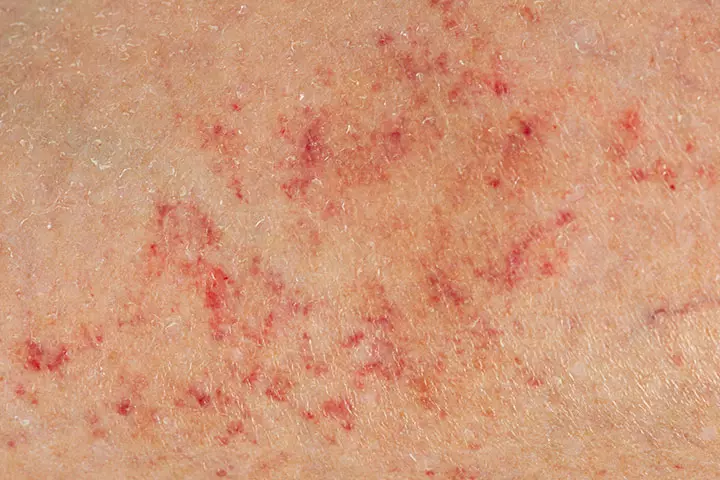
Petechial rashes, or petechiae, are tiny, non-blanching, purple, red, or brown spots under the skin. They appear as 2mm pinpoints and emerge due to bleeding under the skin or in the mucous membranes. These rashes are reported to cause 2.5% of presentations to the pediatric emergency department.
Petechial spots are not oozing, painful, bumpy, raised, or itchy. However, they tend to turn pale on pressure application. Petechiae could be caused by infectious viruses such as enterovirus, parvovirus B19, dengue virus, ebola, and cytomegalovirus. In such cases, children may present symptoms apart from these rashes, including:
- Fatigue
- Fever
- Sore throat
- Cough
- Swollen glands or tonsils
- Body aches
- Nausea or vomiting
- Gastroenteritis
Severe symptoms may also include dizziness or loss of consciousness, trouble breathing, a quick spread of spots, bleeding from mucosal surfaces, and upper gastrointestinal bleeding leading to black stools.
Petechiae, along with the presentation of these symptoms, warrants medical attention. A doctor may take a few tests to determine the underlying cause of the rashes and manage the symptoms accordingly with antibiotics, corticosteroids, and vitamin C supplements (25) (26).
Besides these, some other viral infections that can cause skin rash in children are dengue, zika, West Nile, smallpox, and eczema (including atopic dermatitis). Some of these viral infections spread to children through insects and not from person to person.
Are Viral Rashes Contagious?
Most viral infections in children, such as measles and rubella, spread through contact with body fluids, such as nasal and throat discharge, or via air droplets expelled by the infected person. However, some infections, such as chickenpox and HFMD, spread through contact with the fluids from the rash.
The period in which an infected person can spread the infection to others varies depending on the infection type and other factors, such as immunity. For instance, a child infected with rubella stays contagious one week before and after the appearance of the rash, while a child infected with rubeola stays contagious four days before and after the rash.
When Should You Worry About A Viral Rash?
Some viral rashes are self-limiting and resolve on their own. Nonetheless, if your child experiences a persistent viral rash and unusual symptoms, it’s advisable to consult a doctor. Here are some concerning symptoms you should look out for in your child.
- Breathing difficulty and increased heart rate
- The rash appears near the eyes, genitals, and the mouth
- It worsens with time and doesn’t go away after the expected duration
- Persistent high fever
- Stiffness of the neck and pain in the head, neck, and the ears
- Vomiting and dehydration
If you spot any of these signs in your child, consult their doctor to determine the cause of the rash and ensure prompt and appropriate care.
How Are Viral Rashes Diagnosed?
A physical examination of the rash and evaluation of other signs and symptoms that appear before and after the rash can help the doctor diagnose a viral rash (27). Additionally, the doctor will look into the child’s medical history, vaccination records, recent travel history, and if they have come into contact with an infected person.
The doctor may also order other tests, such as blood and imaging tests, to confirm the diagnosis and look for any possible complications of viral rash in children.
Note: A viral rash often looks similar to other types of rashes, and the other symptoms, such as fever and cough, may be present in other illnesses too. Hence, always consult a pediatrician and seek their guidance for the diagnosis and treatment.
What Are The Treatment Options For Viral Rashes?
Mostly, viral rashes are self-limiting and do not warrant any specific medical treatment. However, if the symptoms persist or worsen, it is best to seek healthcare advice. The treatment is focused on offering symptomatic relief, including reducing the duration and severity of symptoms. For instance, a child may be given over-the-counter pain-relief medicines, such as acetaminophen, in the case of fever and moderate pain; ointments, creams, or lotions, such as calamine lotion, to soothe itchy rash; intravenous fluids (IV), antiviral medications, antihistamines, and steroid creams for severe cases of infection.
Note: Do not administer medicines to children without consulting a pediatrician, as some medications may cause an allergic reaction.
Besides these, home care is the most crucial aspect of treating a viral rash. The following steps will ensure that the child recovers from the infection quickly (28) (29).
- Offer the child plenty of fluids, such as ORS (oral rehydration solution), coconut water, and lemonade to replenish fluid loss due to fever.
- Ask the child to wear loose-fitting clothes to prevent sweating and help the child stay at ease.
- Continue feeding the child as usual. If the child doesn’t feel like eating solids, give them semi-solids or liquids until their appetite resumes.
- Encourage the child to take rest and avoid outdoor activities. This is crucial as it can worsen the symptoms and increase the risk of infection spread.
- Help your child sleep soundly. Make them lie with their head raised slightly using some extra pillows to make breathing easier.
- Encourage your child to maintain optimum hygiene by doing the following.
- Instruct them to bathe with lukewarm water and mild soap daily and apply cool compresses over the affected areas.
- You can also try natural remedies like oatmeal baths to reduce itching and soothe irritated skin.
- Encourage your child to apply a fragrance-free moisturizer after the bath to lock in moisture and prevent further flare-ups.
- Give them tissues to wipe nasal or throat discharge, if any.
- Instruct them to cough and sneeze with their mouth covered.
- Keep a disinfectant handy to clean the surfaces that your child frequently touches to prevent spread.
Besides these, trim the child’s nails and remind them not to scrub the rash. If the rash feels too itchy, ask them to pat it with a clean, soft cloth or tissue.
How To Prevent A Viral Rash?
Viral infections can be best prevented by following optimum hygiene standards and getting routine vaccinations. To defend against viral infections, both children and adults must get up-to-date immunizations.
As a parent, you should maintain proper personal and environmental hygiene and teach your child not to share personal items with others.
If the child is infected, keep them at home to prevent the infection from spreading to other children.
A viral rash can happen in most viral infections. Hence, the best way to prevent a viral rash is to avoid infection. While avoiding exposure to viruses isn’t possible, one can minimize the infection risk by taking vaccinations and adhering to optimum personal and environmental hygiene standards.
Frequently Asked Questions
1. How long do viral hives last in children?
Hives from viral infections can come and go, typically lasting for three to four days (30).
2. Is a rash a symptom of Covid in a child?
Yes. A rash on the toes or fingers is a common symptom of Covid in children. You may see red or purple coloration, swelling, and pus on the toes or fingers. Post Covid infection, some children might develop multisystem inflammatory syndrome (MIS-C), a life-threatening condition. A rash is one of the symptoms of MIS-C, along with bloodshot eyes, cracked and discolored lips, swollen hands and feet, and a swollen tongue that resembles a strawberry. You should consult your pediatrician to rule out the possibility of MIS-C (31).
Most of these common viral rashes are harmless and display mild symptoms that resolve themselves. However, these rashes may cause discomfort, such as itchiness, fever, irritation, and pain. So it is better to stay up to date with the necessary vaccines for your children against the specific viruses. Dealing with a viral rash in children requires adequate home care and minor medication management. If your child still develops a viral rash after precautionary measures and vaccines, consult your pediatrician for prompt and adequate treatment to help prevent complications.
Illustration: Viral Rash On Child: Types Causes Treatment & Prevention

Image: Dall·E/MomJunction Design Team
Learn how to identify several types of viral rashes in children. Compare symptoms to establish the specific type your child may have and safeguard their well-being.
References
- Viral Exanthems (Rashes).
https://www.childrensnational.org/visit/conditions-and-treatments/skin-disorders/viral-exanthems-rashes - Viral Exanthem Rash.
https://my.clevelandclinic.org/health/diseases/22510-viral-exanthem-rash - Clinical Overview of Measles.
https://www.cdc.gov/measles/hcp/clinical-overview/?CDC_AAref_Val=https://www.cdc.gov/measles/hcp/index.html - Measles (Rubeola).
https://kidshealth.org/en/parents/measles.html - Measles Cases and Outbreaks.
https://www.cdc.gov/measles/data-research/index.html - Common Skin Rashes in Children.
https://www.aafp.org/pubs/afp/issues/2015/0801/p211.html - Roseola Infantum.
https://www.merckmanuals.com/home/children-s-health-issues/common-viral-infections-in-infants-and-children/roseola-infantum?autoredirectid=21732 - Roseola.
https://www.nhs.uk/conditions/roseola/ - Roseola.
https://my.clevelandclinic.org/health/diseases/15785-roseola-infantumsixth-disease - Chickenpox.
https://www.seattlechildrens.org/conditions/a-z/chickenpox/ - Chickenpox in Children.
https://www.hopkinsmedicine.org/health/conditions-and-diseases/chickenpox-in-children - Chickenpox.
https://my.clevelandclinic.org/health/diseases/4017-chickenpox - Chapter 22: Varicella.
https://www.cdc.gov/pinkbook/hcp/table-of-contents/chapter-22-varicella.html - About Hand Foot and Mouth Disease.
https://www.cdc.gov/hand-foot-mouth/about/index.html - Hand Foot and Mouth Disease.
https://kidshealth.org/en/parents/hfm.html - Hand foot and mouth disease.
https://dermnetnz.org/topics/hand-foot-and-mouth-disease - Parvovirus B19 and Fifth Disease.
https://www.cdc.gov/parvovirus-b19/about/index.html - Fifth Disease (Parvovirus B19): What Parents Need to Know.
https://www.healthychildren.org/English/health-issues/conditions/skin/Pages/Fifth-Disease-Parvovirus-B19.aspx - Fifth Disease in Children.
https://healthlibrary.brighamandwomens.org/Search/90P01900 - Fifth Disease (Erythema Infectiosum) Fact Sheet.
https://health.maryland.gov/phpa/IDEHASharedDocuments/fifth_disease.pdf - Impact of U.S. MMR Vaccination Program.
https://www.cdc.gov/rubella/vaccine-impact/?CDC_AAref_Val=https://www.cdc.gov/rubella/about/in-the-us.html - About Rubella
https://www.cdc.gov/rubella/about/?CDC_AAref_Val=https://www.cdc.gov/rubella/about/transmission.html - Rubella (German Measles).
https://my.clevelandclinic.org/health/diseases/17798-rubella - Rubella (German Measles Three-Day Measles).
https://www.cdc.gov/rubella/hcp/clinical-overview/index.html - Ailbhe McGrath; Michael J. Barrett; Petechiae
https://www.ncbi.nlm.nih.gov/books/NBK482331/ - Petechiae.
https://my.clevelandclinic.org/health/symptoms/21636-petechiae - Harry D. Mckinnon et al; (2000); Evaluating the Febrile Patient with a Rash.
https://www.aafp.org/pubs/afp/issues/2000/0815/p804.html - Viral illnesses.
https://www.rch.org.au/kidsinfo/fact_sheets/viral_illnesses/ - The Do’s And Don’t’s OF Rashes.
https://www.michigan.gov/-/media/Project/Websites/flintwater/documents/2016/Dos_and_Donts_of_Rashes_Dr_Barkey.pdf?rev=c0c862215cc04642ad1fcfdcf377c6f8 - Hives.
https://www.seattlechildrens.org/conditions/a-z/hives/ - RASH: SIGN OF CORONAVIRUS IN KIDS.
https://www.aad.org/public/diseases/a-z/covid-toes
Community Experiences
Join the conversation and become a part of our nurturing community! Share your stories, experiences, and insights to connect with fellow parents.
Read full bio of Maria Carmela Villania-Mamauag
Read full bio of Swati Patwal
Read full bio of Rohit Garoo
Read full bio of Dr. Joyani Das







